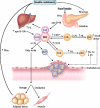Postprandial lipoproteins and cardiovascular disease risk in diabetes mellitus
- PMID: 20425069
- PMCID: PMC2821507
- DOI: 10.1007/s11892-009-0088-4
Postprandial lipoproteins and cardiovascular disease risk in diabetes mellitus
Abstract
Diabetes mellitus is associated with increased risk for atherosclerotic cardiovascular disease (CVD). Recent prospective studies in healthy individuals suggest that the postprandial triglyceride (TG) level is a better independent predictor for assessing future CVD events than fasting TG levels. In contrast, results have been more controversial among diabetic patients, as some studies report a positive association between postprandial TG and CVD. This raises the issue of to what extent postprandial TG levels may be of predictive value in the diabetic population. One possibility impacting on the predictive power of postprandial TG in identifying CVD risk may be the presence of other risk factors, including alterations in lipid and lipoprotein metabolism, which could make it more difficult to identify the impact of postprandial lipemia on cardiovascular risk. The findings provide a challenge to develop a better approach to assess the impact of postprandial lipemia on CVD risk under diabetic conditions.
Figures

References
-
- Grundy SM, Benjamin IJ, Burke GL, et al. Diabetes and cardiovascular disease: a statement for healthcare professionals from the American Heart Association. Circulation. 1999;100:1134–1146. - PubMed
-
- Syvanne M, Hilden H, Taskinen MR. Abnormal metabolism of postprandial lipoproteins in patients with non-insulin-dependent diabetes mellitus is not related to coronary artery disease. J Lipid Res. 1994;35:15–26. - PubMed

